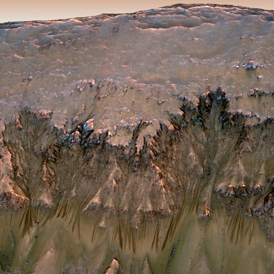Nasa scientists ‘spot flowing water on Mars’
Nasa scientists claim they have discovered new evidence that water flows on Mars, raising the possibility that life could exist on the planet.

The space agency first found signs of water on Mars more than a decade ago, but earlier indications were that any existing water would be frozen and concentrated at the poles.
However, new pictures taken of the “red planet” reveal that water appears to flow off the edges of craters in its southern hemisphere during late spring and summer, before fading in winter and returning the following spring.
The water is thought to be salty and therefore highly resistant to freezing at normal mid-latitude Martian temperatures.
Vesta asteroid pictures almost show 'another world'
Alfred McEwen, the programme’s principle investigator, said scientists “know that the surface is salty from all of the past landers and rovers, from Martian meteorites, from orbital remote sensing”.
That means “any water that flows in the subsurface, or surface, is going to get salty,” he said.
Investigators are also considering whether this water could sustain living organisms.
Lisa Pratt, a biochemist at Indiana University, said that “if the environment is one in which it’s liquid seasonally, but pretty much freezes up solid at other times a year, then that would have to be an organism that could go into a dormant state or could go into a resting state.”
Cosmonauts 'land' on Mars in virtual space mission